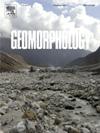新疆西南地区Çine亚地块中粗砾石沉积的形成与演化:多代理方法
IF 3.1
2区 地球科学
Q2 GEOGRAPHY, PHYSICAL
引用次数: 0
摘要
Grus矿床因其形成迅速、对环境因素敏感以及对景观形态的影响,可能是破译花岗岩地貌演化的关键因素。本文研究了半干旱区Çine亚地块(SW t本文章由计算机程序翻译,如有差异,请以英文原文为准。
Formation and evolution of grus deposits in the Çine Submassif, Southwest Türkiye: A multi-proxy approach
Grus deposits may be a key element in deciphering the evolution of granitic landforms due to their rapid formation, sensitivity to environmental factors, and influence on landscape morphology. This study explores the mineralogical, geochemical and structural characteristics of grus deposits developed on granitoid bedrock through subsurface weathering in a semiarid region, the Çine submassif (SW Türkiye), focusing on how topography, mineral composition and climate affect their formation and spatial variability. Two distinct grus types were identified: thinner (0–20 cm), homogenous, sand-rich deposits on upper slopes, and thicker (40–100 cm), heterogenous, gravel-rich layers in the valley and downslope near bedrock outcrops. The bimodal grain-size distributions among grus types may reflect progressive weathering along topographic gradients, where upper slopes experience limited weathering due to reduced water retention and steeper gradients, leading to the formation of thinner, sand-rich deposits. In contrast, downslopes and valleys allow for prolonged water infiltration and feldspar breakdown, resulting in thicker, gravel-rich deposits with a more advanced weathering profile. Grus consists primarily of quartz, albite, orthoclase and mica, with accessory clay minerals such as kaolinite. Geochemical data indicate a felsic grus composition with limited variations, high Chemical Index of Alteration (CIA) values (59 to 69 %), and a gradual weathering trend towards kaolinite, driven by feldspar weathering and fluctuating water infiltration along slopes.
The Principal Component Analysis (PCA) highlights chemical composition and grain size as key parameters differentiating grus types. The interplay of topography, water dynamics, and local structural and mineralogical characteristics controls both the formation and weathering intensity of grus, with variations in deposit characteristics reflecting the influence of slope position and water infiltration on weathering process. These findings provide new insights into granitoid landform evolution, while further geochronological studies are recommended to clarify the temporal evolution of grus mantles and subsurface weathering features across the region.
求助全文
通过发布文献求助,成功后即可免费获取论文全文。
去求助
来源期刊

Geomorphology
地学-地球科学综合
CiteScore
8.00
自引率
10.30%
发文量
309
审稿时长
3.4 months
期刊介绍:
Our journal''s scope includes geomorphic themes of: tectonics and regional structure; glacial processes and landforms; fluvial sequences, Quaternary environmental change and dating; fluvial processes and landforms; mass movement, slopes and periglacial processes; hillslopes and soil erosion; weathering, karst and soils; aeolian processes and landforms, coastal dunes and arid environments; coastal and marine processes, estuaries and lakes; modelling, theoretical and quantitative geomorphology; DEM, GIS and remote sensing methods and applications; hazards, applied and planetary geomorphology; and volcanics.
 求助内容:
求助内容: 应助结果提醒方式:
应助结果提醒方式:


